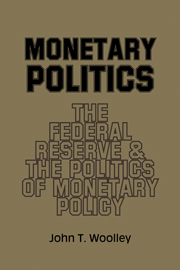Book contents
- Frontmatter
- Contents
- Preface
- 1 The Federal Reserve and the Politics of Monetary Policy: Introduction and Overview
- 2 A Capsule History of the Federal Reserve System
- 3 Recruitment and Selection of Federal Reserve Personnel
- 4 Bankers and the Federal Reserve
- 5 Economists and the Federal Reserve
- 6 The President and the Federal Reserve
- 7 Congress and the Federal Reserve
- 8 Making Monetary Policy in a Political Environment: The Election of 1972
- 9 Monetary Politics: A Summary
- Appendix A A Note on Data Sources
- Appendix B Legislation Included in Table 7.1
- Appendix C Academic Backgrounds and Career Experiences of Notable Monetarists
- Notes
- Bibliographic Note
- Index
6 - The President and the Federal Reserve
Published online by Cambridge University Press: 01 June 2011
- Frontmatter
- Contents
- Preface
- 1 The Federal Reserve and the Politics of Monetary Policy: Introduction and Overview
- 2 A Capsule History of the Federal Reserve System
- 3 Recruitment and Selection of Federal Reserve Personnel
- 4 Bankers and the Federal Reserve
- 5 Economists and the Federal Reserve
- 6 The President and the Federal Reserve
- 7 Congress and the Federal Reserve
- 8 Making Monetary Policy in a Political Environment: The Election of 1972
- 9 Monetary Politics: A Summary
- Appendix A A Note on Data Sources
- Appendix B Legislation Included in Table 7.1
- Appendix C Academic Backgrounds and Career Experiences of Notable Monetarists
- Notes
- Bibliographic Note
- Index
Summary
With the rise of the managed economy after World War II, the presidency emerged as the foremost institution of macroeconomic policy. No others involved in macroeconomic policy are equally important in identifying problems and defining courses of action. One prominent study of the presidency argues that the concerns of macroeconomic policy have been second only to foreign policy for modern presidents. Consequently, various issues of monetary politics arise clearly with respect to the president and his advisors, especially the question of what the objectives of policy should be. In short, presidents seem to be particularly likely to be the real, as opposed to the statutory, superiors of the Federal Reserve.
There are two primary reasons for presidential concern with monetary policy. First, although presidents have no legal authority with respect to monetary policy, they are charged under the Employment Act of 1946 and other legislation with general responsibility for macroeconomic management. Since monetary and fiscal policy are functionally interdependent, presidents have a continuing motivation to assure that monetary policy is consistent with fiscal policy. If presidential duties include stabilizing the economy, then presidents will want to influence all of the powerful instruments of macroeconomic policy.
Second, presidents are interested in monetary policy because of the link between macroeconomic performance and electoral success. It seems reasonably clear that the popularity and electoral success of contemporary presidents are affected by the state of the economy.
- Type
- Chapter
- Information
- Monetary PoliticsThe Federal Reserve and the Politics of Monetary Policy, pp. 108 - 130Publisher: Cambridge University PressPrint publication year: 1984



